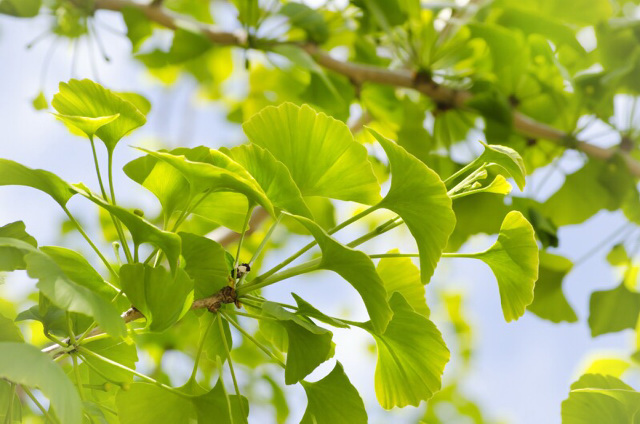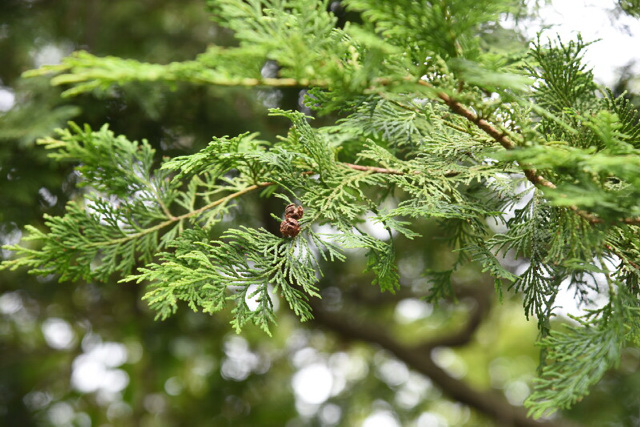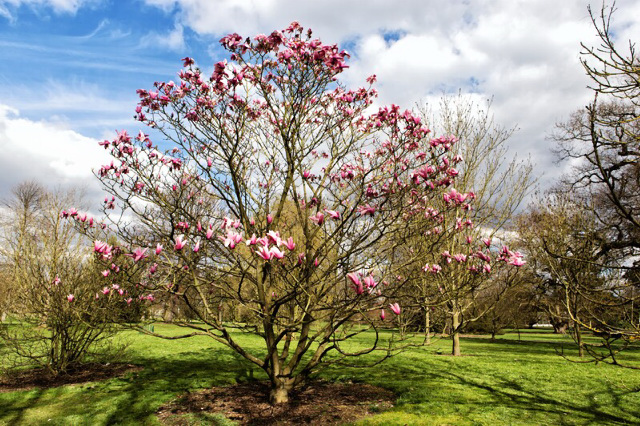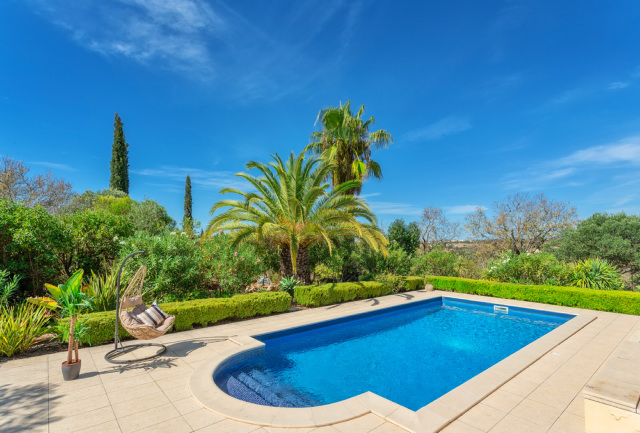Your backyard could use more greenery. You figure some trees around the pool would add shade to your yard and make your pool area more private, especially if you don’t have a fence.
Which trees should you plant around a swimming pool?
Here are some of the best trees to plant around your pool:
- Ginkgo tree
- Cascalote
- Ponytail palm
- Palo verde
- Hinoki cypress
- Juniper tree
- Oleander
- Desert ironwood
- Evergreen ash
- Red cap gum
- Olive tree
- And more
If you want to learn about these exceptional trees, then you’ve come to the right place. Ahead, we’ll provide details about the tree’s size, growth habits, care, and whether it produces fruit and/or flowers.
Our list talks about the right trees to plant, we’ve also got a list of which trees to avoid planting around your pool area: 30 of the Worst Trees to Have Around a Swimming Pool
And if you leave in Texas, we have a specific list just for you: 20 Ideal Plants to Put Around Pool in Texas
We’ll also talk about how to choose the right trees for your pool, so let’s get started!
Article Contents
The 25 Best Trees to Plant Around Your Pool
1. Ginkgo Tree

Topping our list is the ginkgo tree aka the Gingko Biloba. This tree hails from China and has existed for close to 300 million years.
When mature, the ginkgo tree spreads 25 to 35 feet (8 to 11 m) and stands 25 to 50 feet (8 to 15 m) tall. The fan-like leaves of the ginkgo make it quite appealing, and they come in shades of green and gold.
This deciduous tree drops all its leaves simultaneously, which will make for one long weekend of cleanup. At least you can get it all over with at once rather than gradually throughout the season!
2. Cascalote
Hailing from Mexico, the cascalote tree or Caesalpinia cacalaco is a beautiful semi-evergreen tree that is 15 to 20 feet (5 to 6 m) both wide and tall.
The pinnate features leaflet pairs. Also noteworthy is how the cascalote produces flowers over the leaves as fall transitions into winter. The flowers are bright yellow and appealing.
By the end of spring, the cascalote develops red bean pods full of seeds. The seeds become flowers for the next season.
Preferring warm environments where the temperatures don’t drop under 25 Degrees Fahrenheit (-4°C), the cascalote requires well-draining soil and plenty of sun.
One downside is that the stem is quite thorny, so handle it with care!
3. Ponytail Palm
How about a palm to add to the tropical feel of your swimming pool? The ponytail palm or Beaucarnea recurvata grows natively in southeast Mexico’s driest, warmest regions.
Preferring well-draining soil and plenty of sun, this evergreen plant grows slowly. Once it reaches maturity, the ponytail palm is 10 to 15 feet (3 to 5 m) wide and 12 to 25 feet (4 to 8 m) tall.
The fronds that grow from a ponytail palm are three to five feet long apiece.
Before summer arrives, you may see a showing of white flowers. The flowers gradually become seed bracts that encourage more flowers to bloom.
4. Palo Verde
A southwestern staple, the palo verde includes two species, the Parkinsonia florida or blue palo verde and the Parkinsonia aculeata or yellow palo verde, aka the little leaf palo verde.
The term palo verde means “green stick” in Spanish. The trunk and branches of this tree grow green, so the name is quite fitting.
When mature, the palo verde tree grows 20 to 40 feet (6 to 12 m) tall. Seed pods develop from the branches, with seeds of varying sizes depending on the species of the palo verde.
To grow this tree, provide coarse or fine soil in your yard. The foothill palo verde trees can live for upwards of 400 years while blue palo verde trees don’t live nearly as long.
These flowering trees can sometimes lure in insects such as bees, flies, and beetles, which can make swimming in the pool less enjoyable.
5. Hinoki Cypress

A cypress tree such as the Hinoki cypress or Chamaecyparis obtusa could decorate your backyard beautifully.
This East Asian and Japanese tree is a slow-grower. It’s also hard to come by, as it’s considered near threatened.
If you can get your hands on one, the Hinoki cypress grows three feet in diameter and stands 115 feet (35 m) tall. But will take many years before that happens. The bark is a dark brown hue with red while the obtuse leaves are green with a white band across.
This tree’s lumber is much beloved, especially throughout Asia, where it’s used to build masu (square wooden boxes for rice), table tennis blades, noh theaters, shrines, temples, and palaces.
6. Juniper Tree
The evergreen juniper tree includes upwards of 70 species that grow everywhere from Tibet to Central America and the Arctic.
With so many species to choose from, you can find a juniper that fits in your yard and doesn’t grow too large.
On the smaller side, expect a juniper tree to reach heights of 66 inches, and at most, they’ll stand 131 inches (11 ft) tall.
Junipers produce seeds with hard shells that will later become orange, brown, or blue-colored berries. You can add the berries to your spice collection, but maybe don’t eat them.
7. Oleander
The small tree species known as the Nerium or oleander prefers subtropical and temperate regions to grow.
Improving the look of any landscaping with its beautiful flowers, the ornamental oleander is sure to be appealing to swimming pool owners.
The tree can reach heights of seven to 20 feet (6 m). Drought-tolerant, the oleander does not like frost, so keep it out of very cold conditions.
The flowers that an oleander tree produces have five lobes and come in colors like red, pink, or white. You’ll see more flowers in the summer, but the lovely flowers bloom throughout the rest of the year as well!
However, Nerium contains toxic compounds. If someone in your family–especially four-legged friends–ingests parts of the plant, they could experience heart rhythm changes, bloody diarrhea, stomach pain, increased salivation, and vomiting.
8. Desert Ironwood
The palo fierro or desert ironwood, known scientifically as the Olneya tesota, belongs to the same family as legumes.
This perennial tree is native to the Southwestern United States as well as the western Sonoran Desert.
Growing 33 feet (11 m) high, the leaves of the desert ironwood are green-blue. Up to nine leaflets may be attached to one petiole.
In the spring, the desert ironwood will begin blooming, producing flowers that are light pink, magenta-red, or mid-purple.
The desert ironwood secretes sap that hummingbirds and bees like, so those winged creatures could linger around your pool.
9. Evergreen Ash
If you’re looking for a seedless ash tree, the evergreen ash could be the ideal backyard tree to grow around your pool.
We’d recommend the Majestic Beauty variety especially, which possesses sizable leaves that boast a glossy texture.
The Majestic Beauty doesn’t attract insects and it’s also easy to care for. Provide this evergreen tree with full sun and moderate water to keep it happy.
The evergreen ash grows fast, reaching a width and height of up to 40 feet.
10. Red Cap Gum
Western Australia’s red cap gum or Eucalpytus erthyrocorys grows sickle-shaped leaves, but that’s far from all. This tree also produces bell-like fruit and flower clusters that are neon green and feature a red operculum.
An operculum, by the way, is a cap or covering, hence the name red cap gum.
Growing about 20 feet (6 m ) wide and 33 feet (10 m) tall, the red cap gum is widely favored as an accent tree or ornamental plant. It will grow quickly in loamy clay or sandy conditions with a pH range of 5.5 to 6.5.
11. Fruitless Olive Tree
The Olea europaea or olive tree is a small tree species from the Mediterranean Basin.
Although the olives that the olive tree produces are succulent (and free), we’d recommend the fruitless olive tree for your backyard.
You don’t want to have to skim olives out of the bottom of your pool, right? We didn’t think so.
This evergreen tree requires full sun for at least four hours and upwards of eight to 10 hours if you can provide it. Some olive trees do best with partial sun depending on the cultivar.
The olive tree grows about 20 feet (20 m) tall.
12. Banana Tree
In the Musaceae family is the banana tree, which produces the cylindrical, potassium-loaded fruits that so many enjoy.
This perennial, herbaceous outdoor tree grows between two and 30 feet (9 m) tall and can reach widths of 5 feet (2 m).
Give your banana tree full sun exposure, which shouldn’t be hard to do in your backyard where the tree grows poolside. Well-draining, acidic, loamy soil suits a banana tree well.
In the spring, you may see flowers from your banana tree in hues that include orange, purple, or white. Leave the flowers intact, as bananas will someday emerge from them.
The large leaves of the banana tree make this one a shoo-in for backyard plants that will provide shade as you swim in the pool. You can enjoy free bananas as well!
13. Leather Leaf Acacia
The Australian tree known as the leather leaf acacia or Acacia craspedocarpa has leaves with a unique color and texture. The hue is grayish-green with a coarse, almost leathery feel.
That’s not why we’re recommending the leather leaf acacia, though. This evergreen tree is incredibly resilient, as it can withstand high heat and periods of little to no water. It’s also a low-maintenance tree.
The leather leaf acacia grows 15 feet (5 m) wide and tall. Provide well-draining soil and you could see rod-like flowers in a bright, cheery yellow hue.
The flowers are quite appealing to butterflies, which is one insect you won’t mind fluttering around your pool.
14. Magnolia Tree

If you want a flowering tree, then it doesn’t get better than the magnolia. More than 200 species of flowering evergreen or deciduous trees are classified as magnolias.
More than beautiful, magnolia flowers are durable since they require beetles to pollinate them. Why beetles, you ask? Bees hadn’t evolved when magnolias first appeared.
The shape of those flowers varies depending on which magnolia species you select. The flowers are sometimes shaped like stars and other times like bowls.
Magnolia flowers come in several hues, including yellow, green, purple, and pink.
If you want a smaller magnolia tree for the yard, try the Ann Magnolia. It grows 10 to 15 feet (3 to 5 m) tall and eight to 10 feet (3 m) wide.
Do you have a lot of room in the yard? The D.D. Blanchard magnolia expands 30 feet (9 m) wide and is 50 feet (15 m) tall.
15. Citrus Tree
How about a finger lime tree? Maybe a grapefruit tree? Perhaps you like mandarin oranges or lemons?
The beauty of growing citrus trees is that you can enjoy a supple, zippy aroma in addition to being able to harvest your own citrus fruits.
The width of an average citrus tree is 20 feet (6 m) while the height is also 20 feet (6 m). Dwarf citrus tree varieties exist if your yard is smaller but you still want to enjoy the glory of citrus in your yard.
16. False Cypress
What is a false cypress, you ask? The Chamaecyparis is a conifer that grows natively in Taiwan and Japan as well as the western and eastern regions of the US.
These evergreen trees include at least six identified species. They’re exceedingly large, sometimes reaching heights of 230 feet (70 m)!
On the smaller side, a false cypress may grow 66 feet depending on the species you select.
If your false cypress has needle-like foliage, those leaves are younger. The leaves lose that needle texture as they mature. This tree produces cones as well that bear seeds.
17. Holly Tree
Although most people associate holly trees with the Christmas holiday only, they’re a great tree to grow long after you pack away all the tinsel and snowmen decorations.
The holly genus includes more than 550 unique tree species.
The most popular of those species is the Ilex aquifolium aka the European holly. This is the one that holiday songs have been written about, which is why it’s known as the Christmas holly as well.
Although this holly tree species can live for 500 years, that’s incredibly rare. You’ll be lucky if the Ilex aquifolium makes it 100 years.
The prickly leaves of this plant are bright green with a glossy sheen. The red berries seem impossibly bright. The hue likely serves as a warning sign, as holly berries are toxic to pets and people alike.
Eating the berries can lead to symptoms such as drowsiness, dehydration, diarrhea, and vomiting.
18. Japanese Maple
The Japanese maple or Acer palmatum is an elegant maple from southeast Russia, eastern Mongolia, China, Korea, and Japan.
This maple is so beloved that it’s served as the basis for many maple cultivars.
Why is the Japanese maple so popular, you ask? It has dazzling hues and distinct leaf shapes.
Although the care conditions vary by cultivar, the Japanese maple can grow in partial to heavy shade. Full sun may be appropriate, especially if your maple has a darker color like bronze, black, or purple.
A healthy Japanese maple will spread between 15 and 25 feet (5 and 8 m) when it matures.
19. Sago Palm
Another Japanese tree that goes great around a swimming pool is the Cycas revoluta or sago palm. Favored as an ornamental, the sago palm is not a true palm despite its name. Instead, it’s a cycad.
The dark green hue of a sago palm, combined with the glossy texture of the leaves, will spruce up any yard that needs it.
The plant can grow more than 20 inches (2 ft) long and sometimes nearly twice that. The leaves have an average diameter of 3.3 (1 m) feet.
Like some of the other plants we’ve discussed, the sago palm is toxic. The effects extend to humans and animals alike.
The symptoms of sago poisoning include seizures, weakness, bloody diarrhea, and vomiting.
20. Harbor Dwarf Nandina
If you need a very small tree for your pool, the harbor dwarf is it.
Known as the Nandina domestica, the harbor dwarf grows about four feet wide and two feet tall. Its care should be exceptionally easy or at least convenient!
The small leaves cluster close to one another, creating a density that will make your yard a much more private place. This deciduous tree is green but can be red, and its coloration endures even in the winter.
Provide partial shade for the harbor dwarf for several hours per day. The tree needs another six hours of direct sun.
21. Redbud Tree
From east of New Jersey to central and south Mexico, southern Michigan, and other parts of eastern North America, the redbud tree or Cercis canadensis grows.
As Oklahoma’s state tree, the redbud is beloved for its twisting trunk, maroon bark, and pink flowers.
Standing at 30 feet (9 m) tall and spreading up to 33 feet (10 m), the deciduous redbud tree will make a statement in your swimming pool.
22. Crape Myrtle
The Lagerstroemia indica or crape myrtle is another plant that produces stunning pink flowers. The petals of those flowers are very delicate much like the crepe paper this tree is named after.
The leaves are mostly green but can appear red, orange, and yellow as the seasons change.
With its fast growth, the crape myrtle can spread 15 feet (5 m) wide and stand 25 feet (8 m) tall when it reaches maturity.
Caring for the plant requires full sunlight for six hours per day and well-draining but moist soil. Birds may want to live near your crape myrtle, which is something to keep in mind.
23. Pygmy Date Palm
With its tiny size, the pygmy date palm or Phoenix roebelenii could be just what you’re looking for if you don’t have a lot of yard space due to your sizable aboveground or inground pool.
Originating in southeastern Asia, the pygmy date palm is up to 23 feet (7 m) tall. The pinnate leaves can grow quite large between 24 and 47 inches (2 and 4 ft). Each leaf has 100 leaflets.
Flowers? The pygmy date palm has ‘em! The yellow flowers are tiny and become edible fruit that looks a lot like a date.
24. Floss Silk
Flower lovers will gravitate towards the floss silk tree or Ceiba speciosa. This deciduous South American tree is cold-resistant (no freezing temperatures though) and drought-resistant.
That’s not what makes the floss silk such a popular outdoor plant. As we said, it’s those flowers, which are gorgeous neon pink with white insides.
The flowers can grow up to six inches in diameter, so they’re anything but tiny.
By feeding the floss silk plenty of water, you can accelerate its growth. That includes the growth of the hibiscus-like flowers, which attract their fair share of hummingbirds and pollinating insects like bees.
25. Windmill Palm
Last but certainly not least is the windmill palm aka the Trachycarpus fortunei.
Hailing from India, Myanmar, Japan, and China, the windmill palm reaches heights of 66 feet (20 m) mix. The leaves are insanely large too, about 75 inches (6 ft) at their biggest.
The windmill palm grows flowers that are green to yellow.
Fruits emerge from this evergreen palm that becomes ripe in the fall. The fruit is shaped like a kidney bean and sort of colored the same as blueberry or blackberry.

Things to Consider When Choosing Trees for a Pool Area
The above 25 trees all are excellent choices for planting around your swimming pool, so how do you choose?
Well, don’t be afraid to combine a few tree species, that’s for sure. Keep the following points in mind as well as you make your decision.
Visual Appeal
Which trees are the most visually appealing on this list? That’s for you to decide. You might like the tropical feel of palm trees, the sturdiness of maple trees, or flowering trees, of which you more than have your pick.
Shade
A tall tree that looms over your swimming pool (or gets close to its perimeter) will be sure to keep everyone cool on those blistering summer days. If the sunlight is especially unforgiving, you’ll love having trees in your yard!
Privacy
A row of ornamental trees with heavy cover do more than shield you from the sunlight. You also gain privacy on your property. Although trees cannot replace a fence around your home, they come darn near close to creating the same sense of privacy.
Climate
Do you live in a perpetually warm climate or in a cooler region? All outdoor trees and plants are rated according to their hardiness, which refers to how much heat and/or coldness the tree can tolerate.
If you’re interested in growing a tree that doesn’t do well in cold conditions and you live in a frosty region, you’re going to have to reconsider. Your tree won’t last very long!
The same applies if you live in an ultra-hot area and the tree species you’re growing in can’t handle much heat.
Whether the Tree Produces Fruit or Flowers
Flowers are lovely, but what about when the petals start to shed? That’s not so fun.
You’ll have to constantly sweep them from your backyard so they don’t get in the pool. Inevitably though, some petals will end up in the water, where you’ll have to skim them out.
A tree that produces fruits has a different risk associated with it. Curious kids or pets may try to eat the fruits, which are sometimes inedible. Consumption of these fruits could be toxic, as we’ve talked about.
Maintenance
All trees require care, but how much care is the question.
You’re already dealing with the daily responsibilities of family life, your job, your swimming pool, and basic yard care. If a tree is too high-maintenance, you could end up with a lot on your plate.
A low-maintenance tree will make you a lot less stressed!
Roots
Some trees have far-reaching roots. This can be an issue if the roots push against the side or get under your pool. In extreme cases, roots can crack concrete pools and damage pool pipes and lines. This usually takes many years to occur though but it should be considered.
In the end it comes down to choosing the right distance to plant your tree from your pool: How Far Should Trees be Planted From a Pool?
Conclusion
The trees you plant around your swimming pool should be easy to care for, attractive, and hardy for your climate. The species we discussed today come in a variety of sizes and styles to suit any type of backyard!
Related Reading:
How to Hide Pool Equipment in Your Yard
30 of the Worst Trees to Have Around a Swimming Pool
Could Your Swimming Pool Be Earning You Money?

